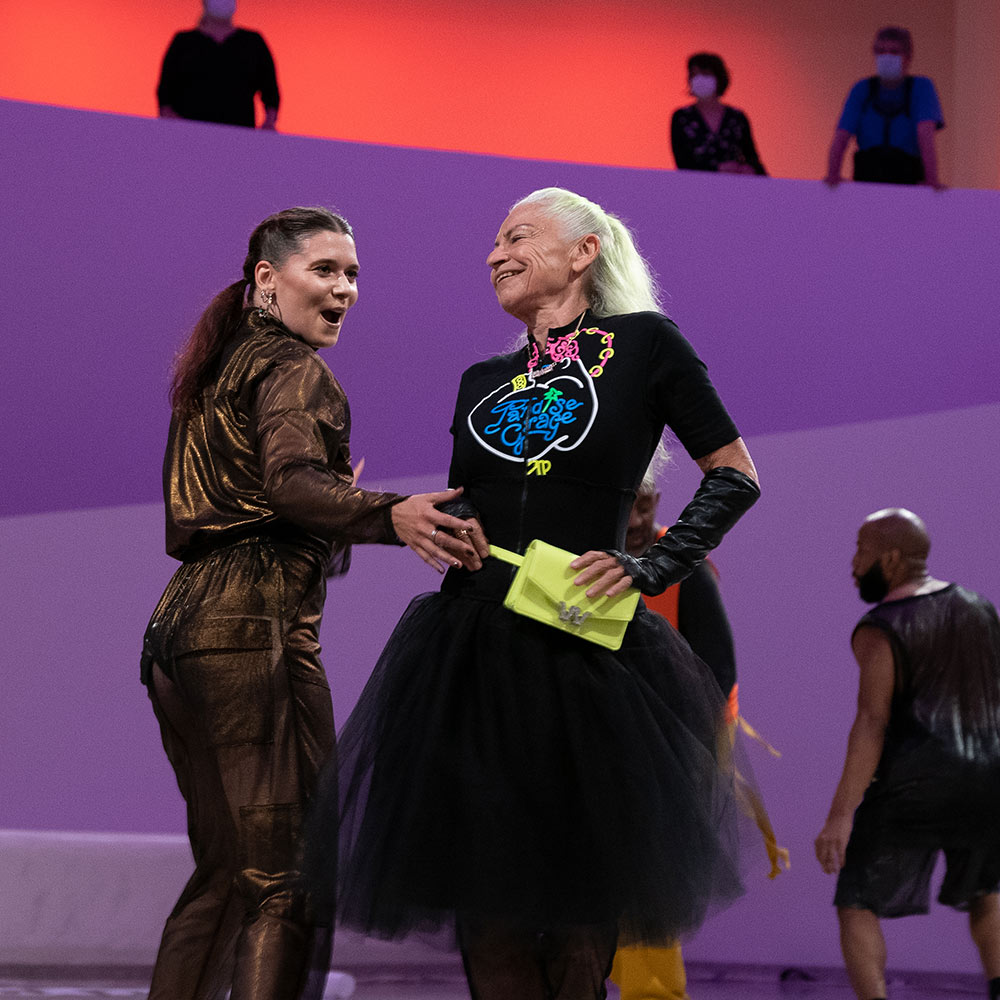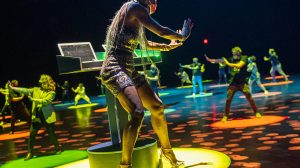
© Erick Munari. (Click image for larger version)
Ephrat Asherie Dance
UnderScored
★★★★✰
New York, Guggenheim Museum
2 June 2021
www.ephratasheriedance.com
www.guggenheim.org
Back at the Guggenheim Museum rotunda, masked again and standing again at the edge of its spiral ramp, I looked down at Ephrat Asherie Dance’s UnderScored, a handsomely patterned, stylized salute to New York City club dancing. This was my final look this spring at the product of one of the Guggenheim’s Works & Process pandemic bubble residencies.
To connect with the history of clubs like Paradise Garage and The Loft, UnderScored features three “legendary elders from the underground dance community.” I only know of the eldest, Michele Saunders, from UnderScored, but Archie Burnett and Bravo “Brahms” LaFortune were already famous house dancers when I saw them in a piece by Doug Elkins in the 1990s and they are prominent in Sally Sommer’s documentary video on club dancing, Check Your Body at the Door.
Burnett is a master of freestyling and waacking and is also the Father (or Grandfather now) of the vogue House of Ninja, founded by the late Willi Ninja. Voguing was established in vogue ballrooms by gay and trans New Yorkers. In Spike (online), Burnett explains, “I’m a straight guy raised in a queer environment.” It is still a queer environment, but also an enveloping one where all sorts of people can become part of ballroom families, which have spread through the world.

© Erick Munari. (Click image for larger version)
LaFortune is famous for his fast footwork, having developed a style on his own combining all sorts of influences from Fred Astaire and the Nicholas Brothers to Soul Train, James Brown, and what he saw at clubs from the late 70s on. Saunders, 77 now, was a devoted club dancer who was very involved in the fashion styling of her favorite club, Paradise Garage. Hence less dancing and a costume change for Saunders in UnderScored, green sequins to start, and a black outfit with colorful embroidery on the top and full layered skirt, with which to make a later entrance.
Burnett and LaFortune are also colorfully clad. LaFortune is in gold pants, tangerine shoes, and an orange sleeveless shirt over a long sleeved black one. Burnett is even more conspicuous amid the dark handsome costumes of Asherie’s troupe. He wears a long lavender coat over loose bright yellow pants. They both notably come to the fore in solo dances within the piece, either alone, or framed by or with other dancers. And both have great presence, whether Burnett is signalling with his arms or merely pointing, or LaFortune is quickly shifting positions, isolating his torso, or diving to the floor.
Though the three elders, particularly Burnett and LaFortune as dancers, are highlighted, much of the dancing is by Asherie’s troupe of seven dancers. Six of them, Asherie and four other women, Manon Bal, Teena Marie Custer, Val “Ms Vee” Ho, and Eriko Jimbo, and one man Matthew “Megawatt” West, often form changing formations within the piece, though they also have solo moments. West moves strikingly, sometimes in the center of the group of women. To recorded cries of “full body,” (the electronic dance music sounds better in this reverberant space than shouted, often indistinct words in the middle of UnderScored), he straddles with bent legs and stomps and dances with unusual full body moves and isolations. Ron “Stealth-1” Chunn Jr. is generally not in the group formations, but has arresting solo moments, too. I think he’s the one who headstands and twists his legs in the air.

© Erick Munari. (Click image for larger version)
It’s not just the men who have breaking moves. Sometimes women do too. Asherie as “Bounce” has a background as a b-girl. But much of the dancing vocabulary seems to be a stylized take off from club dancing. They make jerking moves, for instance, jerking hands, dipping heads, making jerks with different parts of the body. They stalk, they pose, they shift, make discrete isolations, turn and jump, or make swift moves of arms and legs as they travel. Asherie has a knack for mutating formations, so we see lots of different combinations of dancers. For an audience that is viewing from above, she provides arresting views of dancers lying on the floor in intriguing positions. At one point pairs of dancers look like pairs of chromosomes.
Though Burnett and LaFortune may be improvising their solos as they did on the club floor, and others may too, mostly this is a distinctly choreographed club. The dancers enter informally, but soon form a line. From the end of the line a dancer begins to dance, then pauses and passes the impulse to move to the next person and so on down the line. It’s a choreographed suggestion of how people might meet and greet. When women sit on the edge of the little pond on the rotunda floor, this may be a stylized club conversation moment. But at the end, they mill around and devolve into dancing couples as people might in an actual club.
The UnderScored we saw at the Guggenheim in June is only part of the project. Here’s the group at Lincoln Center, pulsing on the edge of the Metropolitan Opera after their first bubble. Works & Process at Lincoln Center: Ephrat Asherie Dance – YouTube Next door to the Met, at the New York Public Library for the Performing Arts’ Jerome Robbins Dance Division, Asherie will have a fellowship to collect oral histories of dancers who, like Burnett, LaFortune, and Saunders, were part of New York’s underground dance scene in the 1970s and 80s.

















You must be logged in to post a comment.